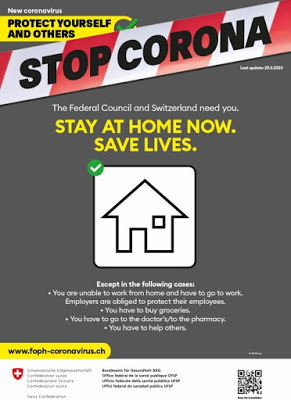Corona Epidemic: Why the lockdown can be loosened
 |
| Werner Vontobel 17/04/2020 |
The latest figures of the Swiss Federal Office of Public Health FOPH show how high the risk of contagion at work and of dying from Covid-19 is.
Tradotto da Milena Rampoldi
First of all: Work itself is not entirely safe. There are work accidents. According to Suva, the Council for Accident prevention, 63 out of 1,000 full-time employees are victims of an occupational accident every year. And
2-3 of 100,000 full-time employees die every year because of a work accident.
There are around 2,400 recognized occupational diseases to be added to this figure per year as well. It is not known how many of them are fatal. Between 20 and 30 percent of the employees – a good one million people – are also affected by psychosocial risks. Therefore, the workplace is not a safe place.
And now the corona risk is added to this picture. The extent of the risk can be estimated on the basis of the most recent figures of the Federal Office of Public Health: According to the study, 24 women and men in the age group between 20 and 60, who are heavily involved in working life, have died as a result of corona disease. Even if we assume that the vast majority of them was infected at work or on their way to work, there are less than 20 work-related corona victims. If we refer this figure to 4.3 million full-time positions in Switzerland, we will statistically get
an additional figure of 0.5 corona deaths per 100,000 full-time employees.
Of the 24 corona deaths in the age group between 20 and 59, less than 19 concern the age group between 50 and 59. As a consequence, their risk of dying from corona is 3.2 times higher than the average risk of the entire working population in Switzerland. More concretely, this means around 1.5 deaths per 100,000 full-time positions. Even if the corona pandemic should continue for several months, the corona risk for this age group would also be in the range equal to the risk of a “normal” work accident
an additional figure of 2-3 corona deaths per 100,000 full-time employees.
And in this context, we’re just talking about the tip of the iceberg of work-related health problems.
As a consequence, the risk of the age group from 50 is likely to be higher since the proportion of people with previous illnesses is significantly higher than among the younger age groups. Let’s take the example of the high blood pressure. 18 percent of the workers between 50 and 59 suffer from it, while in the age group of the young workers it is only a percentage of 6 suffering from high blood pressure. With a rate of 22 percent, men are affected above average. This, as well as the general increase in hypertension patients, are indications that the increasing stress caused by the working life gnaws at our health.
People who died of corona got infected before the lockdown
One may argue that the number of corona deaths to date is only manageable because many employees either do not work, are registered for short-time work or work online from home. However, you have to know that there is an average period of four weeks from the contagion to the (eventual) death. This means that most of the people who died of corona were infected with the virus before the lockdown and before the implementation of the protective measures.
In the meantime, we have made a great progress in the field of safety in the workplace, and the requirement to wear a mask in public transport could further reduce the risk of contagion.
“Human lives sacrificed for business”
Anyone calling for the lockdown to be loosened is accused of sacrificing human lives to “odious money”. This is not entirely wrong, but it ignores the fact that we have always sacrificed human lives and health for economic reasons – the “odious Mammon”. There is no other way.
After all, “the economy” also produces things and services which ensure our survival or make our lives more bearable.
If we want to reduce the “blood tariff” demanded by economic life in an efficient manner and without too much loss, we must focus on other aspects. In the last decades, we have successfully halved fatal accidents at work. Unfortunately, the stress and the psychological damage have increased unnecessarily.
And last but not least, the lockdown continuation also demands its victims. Because worrying about the job, unemployment, and the fear of massive loss of income pose significant health risks. It’s just that the numbers of the affected people are not added up every day.
Which injuries, sick and dead count more?
What weighs heavier now? These or those sick, injured and dead people? The past few weeks have given a clear answer to the question: In the public opinion data weigh heavier if they can be quantified precisely and with high frequency. Above all this is the case when you can draw exponentially rising curves with this data. On the other hand, if the curves flatten or even point downwards, they will tend to disappear from the newspapers.


